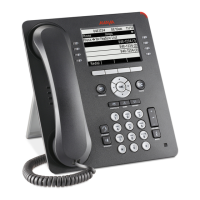Administering deskphone options
114 Administering Avaya 9601/9608/9608G/9611G/9621G/9641G IP Deskphones SIP
Comments? infodev@avaya.com
Another parameter you can administer is VLANTEST. VLANTEST specifies the number of
seconds 9600 Series IP Deskphones wait for a DHCPOFFER message when using a
non-zero VLAN ID. The VLANTEST default is 60 seconds. Using VLANTEST ensures that the
deskphone returns to the default VLAN if an invalid VLAN ID is administered or if the deskphone
moves to a port where the L2QVLAN value is invalid. The default value is long, allowing for a
scenario whena major power interruption causes phones to restart. Always allow time for
network routersor the DHCP servers to return to service. If the deskphone restarts for any
reason and the VLANTEST time limit expires, the deskphone infersthat the administered VLAN
ID is invalid. The deskphone then initiates operation with a VLAN ID.
Setting VLANTEST to 0 indicatesthat the deskphone mustuse a non-zero VLAN indefinitely to
attempt DHCP. In other words, the deskphone does not return to the default VLAN.
!
Important:
Important: If you use DHCP to provision a VLAN ID , then you must also specify L2QVLAN
and VLANTEST in all DHCP servers that the deskphone can potentially use.
Automatically detecting a VLAN
The deskphones support automatic detection of the condition where the L2QVLAN setting is
incorrect. When the value of L2QVLAN is not 0 and you have enabled VLAN tagging initially,
the SIP-based 9600 Series IP Deskphones transmit DHCP messages with IEEE 802.1Q
tagging and the VLAN ID set to L2QVLAN. The deskphones continue to do this for VLANTEST
seconds.
● If L2Q=1 and the VLANTEST timer expires because a DHCPOFFER has not been
received, the deskphone sets L2QVLAN=0 and transmits DHCP messages with the
default VLAN (0).
● If L2Q=0 and the VLANTEST timer expires because a DHCPOFFER has not been
received, the deskphone sets L2QVLAN=0 and transmits DHCP messages without
tagging.
● If VLANTEST is 0, the timer will never expire.

